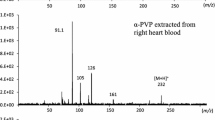Summary
A method for detection and determination of methaqualone and some of its metabolites in autopsy material is described, involving extraction, ultra-violet spectrophotometry, gas and thin-layer chromatography.
Twenty autopsy cases of intoxications were investigated in a detailed fashion. In most cases, the concentration of metabolites in blood, liver and kidney were considerably lower than those of the parent drug, especially when other drugs and/or ethanol also were found. Only small amounts of methaqualone and “free” metabolites were present in the urine. However, after acid hydrolysis, considerable quantities of metabolites were liberated.
A statistical survey of autopsy cases where methaqualone was detected in routine analyses are given. Between, 1964 and June, 197O, methaqualone was detected in 165 autopsy cases, about 90% of these being suicides. 22 cases were intoxications with methaqualone alone. In the remaining ones, death was due to combinations of drugs (including ethanol), or due to physical factors.
From the material presented here, the lower limit of “lethal concentration” in blood seems to be 1–2 mg of drug per 100 ml in pure methaqualone intoxications.
Zusammenfassung
Eine Methode zur Isolierung und Identifizierung von Methaqualon (2-Methyl-3-o-4(3H)-chinazolinon) in Leichenmaterial wird beschrieben. Proben von Leber bzw. Niere werden mit Äthanol homogenisiert und die Suspension zentrifugiert. Die klare Lösung wird abdekantiert und eingedunstet. Im übrigen, sowie auch für Blut und Harn, wurde das Verfahren von Bonnichsen u. Mitarb. (1961) und Maehly und Bonnichsen (1966) verwendet.
Um unverändertes Methaqualon in den Extrakten zu bestimmen, wurden diese gaschromatographisch untersucht. Als stationäre Phase wurde 1% HiEff 3 A verwendet (ein Polyester von Applied Science Laboratories, U.S.A.) und als Träger Gas Chrom Q bei einer Kolonnentemperatur von 190°. Unter diesen Verhältnissen wurden Metaboliten des Methaqualons nicht eluiert.
Mit Hilfe der Ultraviolett-Spektrophotometrie wurde die Gesamtmenge von Methaqualon und gewissen Metaboliten mit annähernd gleichen Spektren bestimmt. In einigen Fällen wurden Extrakte von Blut, Leber und Niere auch dünnschicht-chromatographisch untersucht. Auf den Chromatogrammen konnten außer Methaqualon 3 andere Flecken (manchmal nur 1 oder 2), die mit Dragendorffs Reagens angefärbt werden und Metaboliten von Methaqualon darstellen, entdeckt werden (Abb. 2). Die Metaboliten wurden nicht identifiziert.
Mit den genannten Methoden wurden 20 Fälle von tödlichen Vergiftungen (im allgemeinen Suicide) untersucht. Die Resultate sind in Tabellen 1 und 2 angegeben. Der Anteil von Metaboliten war im allgemeinen viel niedriger als der des unveränderten Methaqualons, besonders wenn auch andere Arzneimittel oder Äthanol vorlagen. Bemerkenswert niedrige Konzentrationen von Metaboliten zeigte Fall Nr. 7 (Tabelle 2), in welchem auch hohe Konzentrationen von Salicylsäure gefunden wurden.
Im Harn wurden nur geringe Mengen von Methaqualon oder „freien” Metaboliten nachgewiesen, saure Hydrolyse setzte hingegen große Mengen „gebundene” Metaboliten frei. Im Blut oder in den Organen wurden nur unbedeutende Mengen von „gebundenen” Metaboliten entdeckt.
Similar content being viewed by others
References
Beyer, K.-H.: Zur fermentativen Aufarbeitung toxikologischen Untersuchungsmaterials. 6. Mitteilung zur Chemie und Analytik der Schlafmittel. Z. anal. Chem.212, 139–145 (1965).
— Klinge, D.: Spaltung der Methaqualone-Glucuronsäurebindung durch β-Glucuronidase. Fermentative Aufarbeitung toxikologischen Untersuchungsmaterials. 5. Mitteilung: Zur Chemie und Analytik der Schlafmittel. Z. klin. Chem.2, 126–127 (1964).
Bonnichsen, R.: Personal communication (1970).
— Maehly, A. C., Frank, A.: Barbiturate analysis: method and statistical survey. J. forens. Sci.6, 411–443 (1961).
Brown, S. S., Smart, G. A.: Fluorimetric assay of methaqualone in plasma by reduction to 1,2,3,4-tetrahydro-2-methyl-4-oxo-3-o-tolylquinazoline. J. Pharm.21, 466–468 (1969).
Bünger, P., Dönhardt, A., Laubinger, G., Nachtwey, W.: Vergiftungen mit dem Hypnotikum Methaqualon. Münch. med. Wachr.106, 2298–2302 (1964).
Burston, G. R.: Self-poisoning with “Mandrax”. Practitioner199, 340–344 (1967).
Caridis, D. T., Mc Andrew, G. M., Matheson, N. A.: Haemodialysis in poisoning with methaqualone and diphenhydramine. Lancet1967I, 51–52.
Curry, A. S.: In: Toxicology, mechanisms and analytical methods, vol. I (Ed.: Stewart, C. P., Stolman, A.). London: Academic Press 1964.
Ford, P. M., Birt, C. A.: Poisoning with Mandrax. Brit. med. J.1967I, 112.
Geldmacher-Mallinckrodt, M., Lautenbach, L.: Zum Nachweis der Revonalvergiftung. Arch. Toxikol.20, 31–37 (1963).
Gitelson, S.: Methaqualone-meprobamate poisoning. J. Amer. med. Ass.201, 977–979 (1967).
Heyndrickx, A., de Leenheer, A.: Clinical toxicology of the metabolites of methaqualone in man. Europ. J. Toxicol.2, 66–59 (1969).
Holmberg, G., Wiklund, P.-E.: Intoxikationer med preparat innehållande metakvalon. Läkartidn (in press) (1970).
Ibe, K.: Die akute Methaqualon-Vergiftung. I. Statistik, Literaturübersicht und Kasuistik. Arch. Toxikol.21, 179–198 (1965).
— Die akute Methaqualon-Vergiftung. II. Mitteilung. Klinik, Pathophysiologie und Therapie. Arch. Toxikol.21, 289–309 (1966a).
— Die akute Methaqualon-Vergiftung. III. Mitteilung. Klinisch-chemisch-toxikologische Untersuchungen. Arch. Toxikol.22, 16–23 (1966b).
Knoke, M., Schlabitz, H.-D.: Die Methaqualon-(Dormutil®)- Vergiftung. Dtsch. Gesundheits-Wes.22, 439–443 (1967).
Lawson, A. A. H., Brown, S. S.: Poisoning with Mandrax. Brit. med. J.1966II, 1455–1456.
— Acute methaqualone (Mandrax) poisoning. Scot. med. J.12, 63–68 (1967).
Maehly, A.: Lethal intoxications by volatiles: methods and results. J. forens. Sci.9, 470–476 (1964).
— Bonnichsen, B.: Fünf tödliche Vergiftungen mit Methaqualon (2-Methyl-3-o-tolyl-4(3H)-chinazolinon) in Schweden. Dtsch. Z. ges. gerichtl. Med.57, 446–450 (1966).
Matthew, H., Proudfoot, A. T., Brown, S. S., Smith, A. C. A.: Mandrax poisoning. Conservative management of 116 patients. Brit. med. J.1968II, 101–102.
Nowak, H., Schorre, G., Struller, R.: Untersuchungen zum Metabolismus von Methaqualon. Arzneimittel-Forsch.16, 407–411 (1966).
Preuss, F. R., Hassler, H.-M., Köpf, R.: Zur Biotransformation des 2-Methyl-3-o-tolyl-4(3H)-chinazolinon (= Methaqualon). I. Mitteilung: Analytik und Isolierung der renalen Ausscheidungsprodukte sowie Identifizierung einiger Metaboliten. Arzneimittel-Forsch.16, 395–401 (1966a).
— Zur Biotransformation des 2-Methyl-3-o-tolyl-4(3H)-chinazolinon (Methaqualon). 2. Mitteilung: Zur Struktur und Synthese einiger renaler Ausscheidungsprodukte. Arzneimittel-Forsch.16, 401–407 (1966b).
Proudfoot, A. T., Noble, J., Nimmo, J., Brown, S. S., Cameron, J. C.: Peritoneal dialysis and haemodialysis in methaqualone (Mandrax) poisoning. Scot. med. J.13, 232–236 (1968).
Sanderson, J. H., Cowdell, R. H., Higgins, G.: Fatal poisoning with methaqualone and diphenhydramine. Lancet1966II, 803–804.
Schmitt, A.: Besonderheiten bei Vergiftungen mit barbitursäurefreien Schlafmitteln. Nervenarzt33, 418–419 (1962).
Stahl, E.: Dünnschicht-Chromatographie. Ein Laboratoriumshandbuch, 2nd ed. Berlin-Heidelberg-New York: Springer 1967.
Tompsett, S. L.: Methaqualone poisoning. Bull. int. Ass. forensic Toxicol.5/1, 6 (1968).
Wilkinson, M. B.: Poisoning with Mandrax. Brit. med. J.1967I, 301.
Author information
Authors and Affiliations
Rights and permissions
About this article
Cite this article
Frøslie, A., Schubert, B. Analysis of methaqualone in autopsy material. Z Rechtsmed 67, 342–358 (1970). https://doi.org/10.1007/BF02083041
Received:
Issue Date:
DOI: https://doi.org/10.1007/BF02083041




